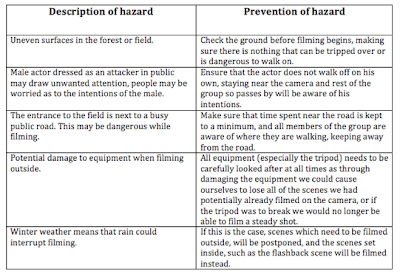Planning soundtrack
The soundtrack to a film is extremely important in order to connote a mood or atmosphere to the audience, helping them to put themselves in the same situation as the character and therefore enabling them to experience the same feelings of tension, suspense and anxiety as the main protagonist in a thriller film. It also enables the director to connote different ideas about the upcoming events of the film to the audience, for example deep, dark, suspenseful music played whilst a man dressed in dark clothing walks alone will foreshadow a sinister future for this character in the rest of the film.
For the soundtrack of our group thriller film, we discussed the type of music that we would like to include. We know, that in order to create thick tension within our narrative the music needs to convey a dark atmosphere, as though something terrible is about to happen. The clip below is a perfect example of the type of music we would like to include within our film. The tense sounds would be perfect for a foreboding atmosphere that we are aiming to create within the opening sequence, causing the audience to be in a state of suspense as they wait for the sinister actions that they know will take place soon.
http://ccmixter.org/files/nickleus/28581
Another example of sound that we aim to include in the film is natural sound. This creates a sense of realism, as the audience can identify with the events taking place and realise that there is a possibility, no matter how small, that these events could take place in real life. This creates an even more terrifying feel to the narrative as the audience puts themselves so vividly into the shoes of the character.
We also found a short clip of four voices whispering in a sinister, yet unintelligible manner. We discussed as a group, where this music could best be used, and we came up with the idea that it would sound best in the scenes where the attacker is stalking his victim, while she walks home unaware of his presence. Through the use of this sound we intend to create an especially spooky atmosphere as the voices could be representative of the dark voices which haunt his mind, spurring him on.
http://www.freesound.org/people/geoneo0/sounds/143902/
The three examples of music above will enable us to create a tense, yet electrifying atmosphere as the audience watches the events unfold. It will add huge dramatic impact to our film, as music is the key to making a scene even more suspenseful than it would have been otherwise.
We also found a short clip of four voices whispering in a sinister, yet unintelligible manner. We discussed as a group, where this music could best be used, and we came up with the idea that it would sound best in the scenes where the attacker is stalking his victim, while she walks home unaware of his presence. Through the use of this sound we intend to create an especially spooky atmosphere as the voices could be representative of the dark voices which haunt his mind, spurring him on.
http://www.freesound.org/people/geoneo0/sounds/143902/
The three examples of music above will enable us to create a tense, yet electrifying atmosphere as the audience watches the events unfold. It will add huge dramatic impact to our film, as music is the key to making a scene even more suspenseful than it would have been otherwise.




















